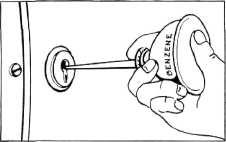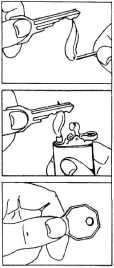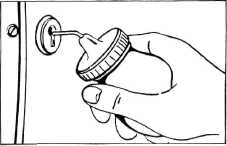1942 - 1947 CHEVROLET SHOP MANUAL
Section 1 Body
|
|
||||
|
1-28
|
||||
|
|
||||
 |
the key from
entering. There are several methods by which a frozen lock may be
thawed out.
|
|||
 |
One is to take the car
to a warm garage where the lock will thaw out
naturally in a few minutes.
If this is not possible, heat the key,
using a lighted match or
cigarette lighter, or in the hand, Fig. 53. After the key has been
heated, quickly insert it in the lock. The heat from the key will be
absorbed by the brass tumblers and cause the ice to melt. It may be
necessary to repeat this procedure several times to melt all of the
ice.
Do not leave the key
in the lock under these conditions long enough to permit the
possibility of the key freezing to
|
|||
|
Fig. 51-Injecting Fluid to Clean Lock Cylinder
dirt. Never use
penetrating oil or any cleaning fluids to clean the interior of
locks—these fluids act as dust collectors.
How to Lubricate Locks
After thoroughly
cleaning the lock, blow micro-fine graphite into the lock through the
key hole, using a dispenser such as shown in Fig. 52.
|
||||
 |
||||
|
the lock.
|
||||
|
Fig. 53-Heating Key to
Thaw Out Frozen Lock
|
Another method is to
|
|||
|
force a little alcohol
into the lock through the keyhole; this will also melt the ice. Care
should be used with this method since alcohol will damage any finish
on the car with which it may come in contact.
Once the lock is
opened and in working condition, it should be cleaned, blown out and
lubricated with graphite.
To Remove Broken Keys
When a key twists off
in a lock it is usually because the key was not fully inserted, or due
to excessive effort to turn the key when the tumblers were sticking
because of dirt, rust or ice inside.
NOTE—Never attempt
to turn a key in the lock unless it is fully inserted into the lock.
To remove a broken
key, grind a sharp hook on one end of a piece of steel wire, bending
the other end into a loop, Fig. 54. Insert the hooked end of
the wire into the key hole as far as possible, then catch the hook on
the broken piece of the key and pull it out. Fig. 54.
|
||||
|
Fig. 52-Lubricating Lock Cylinder
Then work the key in
and out five or six times to distribute the graphite. To prevent
soiling clothing, wipe all excess graphite from the key and around
the lock.
Frozen Locks
Locks will
occasionally freeze up and become
inoperative as a result of moisture getting into them due to
rain, sleet and snow, or water may get into the locks while the car is
being washed. A small piece of adhesive or masking tape placed over
the keyhole and cover of each lock will prove very effective in
preventing the entrance of water, and will avoid much difficulty,
particularly during winter weather. Alternate hot and cold conditions
will cause condensation and produce moisture within a lock.
There is very little
area inside a lock for ice, but one drop of water when frozen may
easily prevent
|
||||
 |
||||
|
Fig. 54-Removing Broken Key from Lock
|
||||
|
|
||||